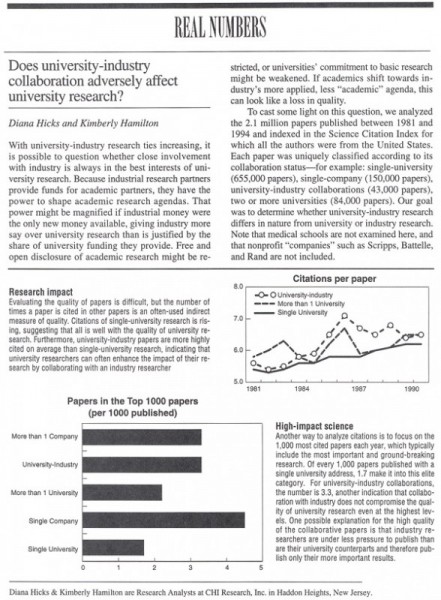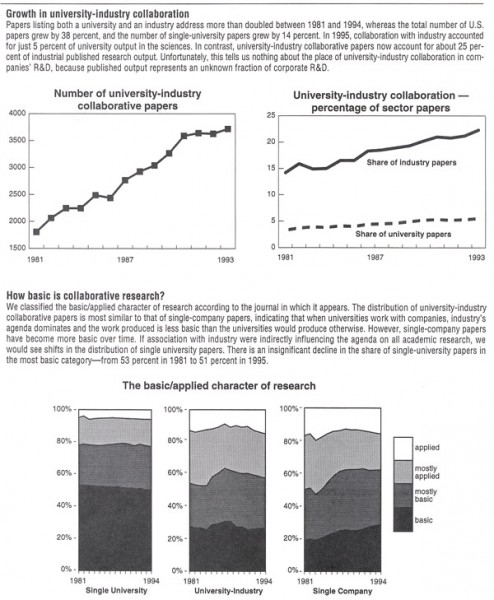Does university-industry collaboration adversely affect university research?
Below is the page above transcribed into this article post.
With university-industry research ties increasing, it is possible to question whether close involvement with industry is always in the best interests of university research. Because industrial research partners provide funds for academic partners, they have the power to shape academic research agendas. That power might be magnified if industrial money were the only new money available, giving industry more say over university research than is justified by the share of university funding they provide. Free and open disclosure of academic research might be restricted, or universities’ commitment to basic research might be weakened. If academics shift towards industry’s more applied, less “academic” agenda, this can look like a loss in quality.
To cast some light on this question, we analyzed the 2.1 million papers published between 1981 and 1994 and indexed in the Science Citation Index for which all the authors were from the United States. Each paper was uniquely classified according to its collaboration status~~for example: single-university (655,000 papers), single-company (150,000 papers), university-industry collaborations (43,000 papers), two or more universities (84,000 papers). Our goal was to determine whether university-industry research differs in nature from university or industry research. Note that medical schools are not examined here, and that nonprofit “companies” such as Scripps, Battelle, and Rand are not included.
Research impact
Evaluating the quality of papers is difficult, but the number of times a paper is cited in other papers is an often-used indirect measure of quality. Citations of single-university research is rising, suggesting that all is well with the quality of university research. Furthermore, university-industry papers are more highly cited on average than single-university research, indicating that university researchers can often enhance the impact of their research by collaborating with an industry researcher
High-impact science
Another way to analyze citations is to focus on the 1,000 most cited papers each year, which typically include the most important and ground-breaking research. Of every 1,000 papers published with a single university address, 1.7 make it into this elite category. For university-industry collaborations, the number is 3.3, another indication that collaboration with industry does not compromise the quality of university research even at the highest levels. One possible explanation for the high quality of the collaborative papers is that industry researchers are under less pressure to publish than are their university counterparts and therefore publish only their more important results.
Diana Hicks & Kimberly Hamilton are Research Analysts at CHI Research, Inc. in Haddon Heights, New Jersey.
Growth in university-industry collaboration
Papers listing both a university and an industry address more than doubled between 1981 and 1994, whereas the total number of U.S. papers grew by 38 percent, and the number of single-university papers grew by 14 percent. In 1995, collaboration with industry accounted for just 5 percent of university output in the sciences. In contrast, university-industry collaborative papers now account for about 25 percent of industrial published research output. Unfortunately, this tells us nothing about the place of university-industry collaboration in companies’ R&D, because published output represents an unknown fraction of corporate R&D.
How basic is collaborative research?
We classified the basic/applied character of research according to the journal in which it appears. The distribution of university-industry collaborative papers is most similar to that of single-company papers, indicating that when universities work with companies, industry’s agenda dominates and the work produced is less basic than the universities would produce otherwise. However, single-company papers have become more basic over time. If association with industry were indirectly influencing the agenda on all academic research, we would see shifts in the distribution of single university papers. There is an insignificant decline in the share of single-university papers in the most basic category~~from 53 percent in 1981 to 51 percent in 1995.


